090524_THEVERYMANY @ SELFRIDGES

Proposal for an installation:
SELFRIDGES - CORNER STORE FRONT LONDON October 2008
The scheme was part of a design call under the theme of "Explosion"...

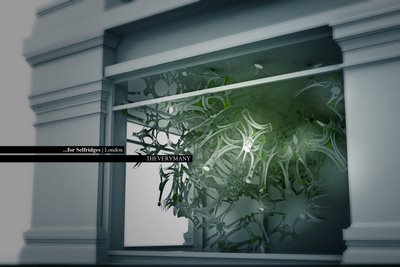

ON ANALOGIES:
THEVERYMANY very much acknowledge the fact that - even though it focuses exclusively its research and practice on what it self-defines as “explicit and encoded” techniques of design (also described by Marc Fornes as “text based morphologies”) – any design process - whenever based on a top down “idea” or theme - requires first a process of translation back into the design paradigm which is very much based on selective reading, subjective interpretations and analogies…
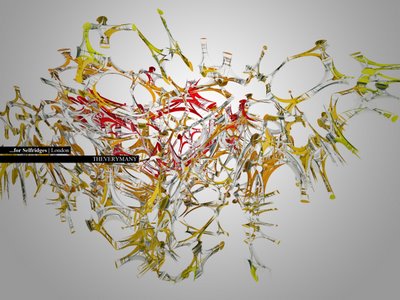
EXPLOSION (ie Wikipedia.org)
An explosion is a sudden increase in volume and release of energy in an extreme manner, usually with the generation of high temperatures and the release of gases. An explosion creates a shock wave.
DUST EXPLOSION (ie Wikipedia.org)
A dust explosion is the explosive combustion of a dust suspended in air in an enclosed location, which results in harmful effects of overpressure, thermal radiation, and ensuing projectiles.
DEFLAGRATION (ie Wikipedia.org)
Deflagration (Lat: de + flagrare, "to burn down") is a technical term describing subsonic combustion that usually propagates through thermal conductivity (hot burning material heats the next layer of cold material and ignites it). Most "fire" found in daily life, from flames to explosions, is technically deflagration.
DETONATION (ie Wikipedia.org)
Detonation is a process of combustion in which a supersonic shock wave is propagated through a fluid due to an energy release in a reaction zone. It is the more powerful of the two general classes of combustion, the other one being deflagration. In a detonation, the shock compresses the material thus increasing the temperature to the point of ignition. The ignited material burns behind the shock and releases energy that supports the shock propagation. This self-sustained detonation wave is different from a deflagration, which propagates at a subsonic rate (i.e., slower than the sound speed in the material itself). Because detonations generate high pressures, they are usually much more destructive than deflagrations.
SHOCK WAVE (ie Wikipedia.org)
A shock wave (also called shock front or simply "shock") is a type of propagating disturbance. Like an ordinary wave, it carries energy and can propagate through a medium (solid, liquid or gas) or in some cases in the absence of a material medium, through a field such as the electromagnetic field. Shock waves are characterized by an abrupt, nearly discontinuous change in the characteristics of the medium.
When a shock wave passes through matter, the total energy is preserved but the energy which can be extracted as work decreases and entropy increases. This, for example, creates additional drag force on aircraft with shocks.

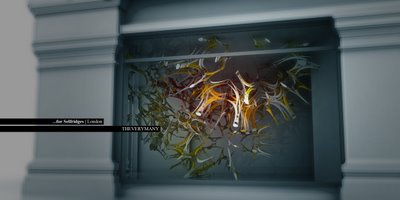
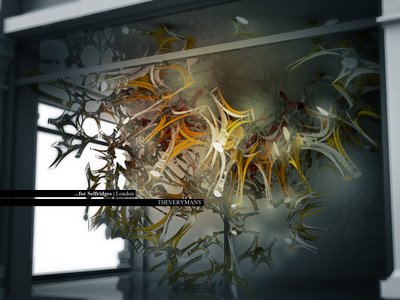
TRIGGERS:
While that design proposal isn't about “reproducing”, "simulating" or even "mimicking" the esthetic of an explosion – the project is proposing a very articulated geometrical assembly based on specific and curated themes extracted within the field of explosion…
- Projectiles – the project is investigating the concept of numerous “parts” able to produce a non linear assembly – all the parts owns to a precise initial catalogue and can be reconfigured in a similar manner then projectiles can be re-assembled (in theory) into their original parent morphology…
- Increase of volume – the project is looking at ways to create volume from planar components all CNC cut from sheet based materials…
- Propagation through medium – while there is a very limited amount of initial geometrical primitives – the project investigates construction sequence through color differentiation across the entire construct…
- Enclosed location – well…
To be continued...
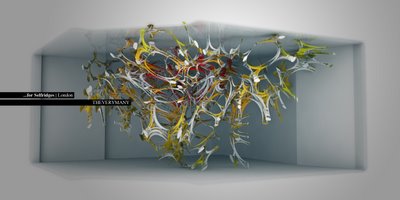
CREDITS:
Proposal for: SELFRIDGES London October 2008
Design: THEVERYMANY
Team: Marc Fornes, Skylar Tibbits
Scripting: Marc Fornes
Labels: computation, design, explosion, installation, london, marc fornes, rhinoscripting, selfridges, store front, theverymany


<< Home